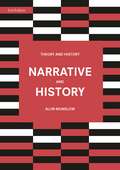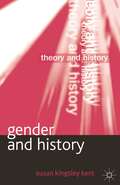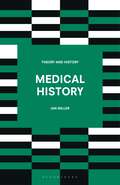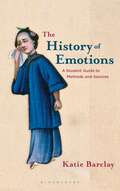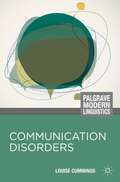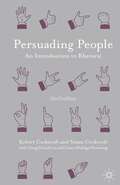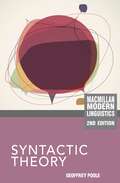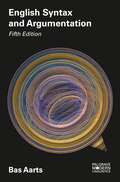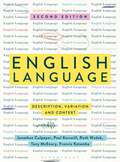- Table View
- List View
History of the Body (Theory and History)
by Willemijn RubergThe body has come to occupy a central place in cultural history, with historians consistently exploring such themes as the history of disease, disability, beauty, and sexuality. This engaging and concise book offers a clear introduction to the history of the body, introducing a wide array of conceptual approaches to the field. It delineates the topic of body history and its origins in cultural history and gender history, distinguishing it from related disciplines such as the history of the self, the history of medicine, the history of emotion and gender history. Bringing in a wealth of thought-provoking examples from historical writing, it goes on to explore a range of themes, including racism, anorexia, gender and sexuality, psychoanalysis and agency. With further reading and explanations of key concepts provided throughout, this wide-ranging yet accessible text is the first introductory book to address this vibrant field from a theoretical perspective. It is ideal for students of historiography, medical history or the history of the body.
Information History in the Modern World: Histories of the Information Age (Themes in Focus)
by Toni WellerInformation has a rich but under explored history. The information age of the late twentieth century witnessed the emergence of a new history of information and, in this timely collection of essays, a team of international scholars from a variety of disciplines examines the changing understandings of information in the modern world.Situating the concept of information in varying historical contexts since the eighteenth century, Information History in the Modern World: Histories of the Information Age:- Explores how this historical research can challenge our perceptions of the information age in the global twenty-first century- Discusses ephemera, wars, imagery, empire, identification and the transience of history in the digital era- Argues that the changing uses, perceptions and manifestations of information helped to shape the world we know today.Authoritative and approachable, this is an invaluable resource for anyone who is interested in how and why information has become a distinguishing feature of the modern world.
Narrative and History (Theory and History)
by Alun MunslowBased on the assumption that reality, reference and representation work together, this introductory textbook explains and illustrates the various ways in which historians write the past as history. For the first time, the full range of leading narrative theorists such as Paul Ricoeur, Hayden White, Frank Ankersmit, Seymour Chatman and Gérard Genette have been brought together to explain the narrative-making choices all author-historians make when creating historical explanations. Combining theory with practice, Alun Munslow expands the boundaries of the discipline and charts a new role for unconventional historical forms and modes of expression.Clear but comprehensive, this is an ideal resource for undergraduate and postgraduate students taking courses on history and theory, history and method, and historiography.
The Future of History
by Alun MunslowIn this radical reassessment, Alun Munslow challenges conventional notions of history and offers a new vision of historical thinking and practice. Deploying a range of concepts such as scepticism, aesthetics, ethics, standpoint, irony, authorship and a new understanding of truth, The Future of History examines history as a form of knowledge in itself, arguing that in the future the multiple forms of its expression will be as significant as its content. This thought-provoking, challenging and unique book offers a way forward for history after postmodernism and is essential reading for anyone asking the question 'what is history?'.
Using Computers in History
by Sonja Cameron Sarah RichardsonInformation and communications technology is now an essential tool for the historian and for anyone engaging in historical study. Today's 'history workstation' includes computers, modems, scanners, printers, digital cameras and a wide range of software applications to access the World Wide Web and to analyse historical sources. Sonja Cameron and Sarah Richardson provide a clear, jargon-free introduction which demystifies the computing skills needed for historical research.This step-by-step guide covers all aspects of history and computing including:- Presentation: from word-processing an article which conforms to scholarly protocols to presenting a slide show.- History and the World Wide Web: hints and tips on accessing and evaluating the wide range of historical material available on the internet.- Databases: a clear introduction which guides you through the process of creating your own database of historical sources.- Spreadsheets: a lucid explanation of basic quantitative methods, data analysis, graphing and charting.- Digitised text and images: help on analysing digitised text, creating images and web pages.The text is supported throughout by worked examples using historical sources, comprehensive illustrations, a detailed glossary and signposts to further study where appropriate. Using Computers in History is an indispensable aid to all those studying and researching history. Students, family and local historians, and history enthusiasts will all find this book informative and easy-to-use.
Gender and History (Theory and History)
by Susan Kingsley KentWhat is gender and who has it? History, theory and gender are inextricably linked, but how exactly do they fit together? How dohistorians use theories about gender to write history?In this jargon-free introduction, Susan Kingsley Kent presents a student-friendly guide to the origins, conceptual framework, subjectmatter and methods of gender history. Assuming no prior knowledge, Gender and History: - Sets out clear definitions of theory, history and gender- Explains that gender is not solely applicable to women, but to men as well- Tackles the hotly debated topic of power and gender relations- Explores gender history from a variety of angles, including anthropology, psychology and philosophy- Spans a broad chronological period, from the times of Aristotle to the present day- Includes a helpful glossary that explains key terms and concepts at a glanceLively and approachable, this is an essential text for anyone who wishes to learn how to use theories of gender in their historical studies.
Studying Gender in Medieval Europe: Historical Approaches
by Patricia SkinnerBuilding on over a century of scholarly achievements and advances, this book addresses the core problem of how to incorporate gender in the study of the history of medieval Europe, and why it is important to do so. Providing a succinct overview of the field, Patricia Skinner guides us through debates and innovations in the study of gender in medieval history. Noting that the rise of gender studies has happened at a different pace in different regions, this unique text addresses the national variations of approach visible in US and European scholarly traditions.Packed with key authors, alternative approaches and suggestions for engaging with medieval sources, this text is an essential tool for students and scholars of medieval history at all levels.
Medical History: Hunger Strikes, Prisons And Medical Ethics, 1909 1974 (Theory and History)
by Ian MillerThis introductory textbook presents medical history as a theoretically rich discipline, one that constantly engages with major social questions about ethics, bodies, state power, disease, public health and mental disorder. Providing both instructors and students with an account of the changing nature of medical history research since it first emerged as a distinct discipline in 19th century Germany, this essential guide covers the theoretical development of medical history and evaluates the various approaches adopted by doctors, historians and sociologists.Synthesising historiographical material ranging from the 19th to 21st centuries, this is an ideal resource for postgraduate students from History and History of Medicine degrees taking courses on historiography, the theory of history and medical history.
The History of Emotions: A Student Guide to Methods and Sources (Routledge Guides To Using Historical Sources Ser.)
by Katie BarclayThis student guide introduces the key concepts, theories and approaches to the history of emotions while teaching readers how to apply these ideas to historical source material. Covering the main emotions approaches and providing a range of global case studies and historical sources with which to apply learning, this textbook provides a 'how to' guide for those new to the field and for those learning how historians apply methods to source material. Written in clear and accessible language, each chapter is accompanied by further reading, while surveying many of the main areas of current research and providing ideas for personal research projects and further learning. This methodological guide is ideal for students taking modules on the History of Emotions, or for students on general Historical Skills modules.
Communication Disorders (Macmillan Modern Linguistics)
by Louise CummingsWhat are communication disorders? How are they identified, assessed and treated?This introductory textbook presents the full range of developmental and acquired communication disorders, including specific language impairment, dysarthria, apraxia of speech, aphasia and stuttering. Covering clinical features, diagnosis and treatment, the book is an indispensable resource for students of linguistics, and speech and language therapy.Communication Disorders also: - Includes clinical linguistic data throughout to illustrate specific features of communication disorders- discusses disorders often neglected in introductory books, such as glossectomy and gender dysphoria- Contains in-text references to a companion website which has colour photographs, audio and video files, and 200 self-test questions - Provides exercises with answers, key point boxes, case studies, suggested readings and a glossary
Language in Business, Language at Work
by Erika Darics Veronika KollerPacked with contemporary examples from the business world, this is an exciting and engaging text which explains how language works in business, how to analyse it and how to use it in an informed and creative way.The book is split into three parts, which look at business communication from corporate, management and employee perspectives. Wide-ranging in nature, it explores a variety of topics ranging from stakeholder communication and brand narratives to managing conflict and self-branding. Each chapter contains ample opportunity for readers to put new skills into practice, while case studies act as springboards for further discussion.This is essential reading for students of both language and business-related disciplines, both during and beyond their studies. It is also an indispensable resource for teachers of business communication.
Persuading People: An Introduction to Rhetoric
by Robert Cockcroft Susan Cockcroft Craig HamiltonThis fascinating and practical book explores persuasive techniques in the English language, and is the ideal introduction for students and others with a professional interest in persuasion. Using a wide range of lively and accessible illustrative material, Robert Cockcroft and Susan Cockcroft unpick the complexities of persuasive language - both written and spoken - and enable readers to develop and enhance their rhetorical skills.Now thoroughly revised and expanded, the second edition of this successful text includes:- Developed application of cognitive linguistic theory, which sheds new light on the emotional and logical powers of persuasion- Extended and updated examples of rhetoric in action- Clear pointers for further study to allow readers to continue their exploration into rhetorical theory and practice- A new final chapter which invites readers to practice their skills using updated versions of traditional rhetorical exercises
Syntactic Theory (Macmillan Modern Linguistics)
by Geoffrey PooleThis is a highly recommendable book. It elegantly introduces generative grammar as an empirical science. Written in a clear and friendly tone, it is extremely readable and makes complicated linguistic theory accessible to students' - Ken Ramshøj Christensen, Aarhus University, DenmarkThis clear and practical introduction to Syntactic Theory introduces students to theory building, hypothesis testing and evaluation through the framework of Chomsky's Government-Binding Theory. Initial chapters guide the student through essential topics such as X'-Theory, Transformations and elementary Binding Theory, progressing to cover more advanced issues such as Reconstruction, the light verb vP and control as movement. Presenting the core linguistic theory and problem solving skills that are essential to the subject, this updated and revised second edition features:• New material on the Minimalist Program and Government-Binding Theory• Expanded chapters on Phrase Structure and Functional Categories• A wealth of new tree diagrams as well as revised end-of-chapter exercisesThe liberal use of in-text exercises engage the reader at every stage of theory-development, while an 'Open Issue' at the end of each chapter encourages active participation and further exploration of the chapter's topic. With an engaging, informal style, Syntactic Theory makes the most difficult topics accessible to a wide range of students.Clear, practical and accessible, Syntactic Theory introduces students to theory building and evaluation through Government-Binding Theory. Now fully updated, this second edition features new chapters on the Minimalist Program, expanded chapters on Phrase Structure and Functional Categories and extensively revised end-of-chapter exercises.
What Is This Thing Called Language?
by David NunanWritten by eminent linguist David Nunan, this concise text immerses readers in the complex, curious and continually evolving phenomenon that is at the centre of everything we do: language. It can be fascinating, puzzling and entertaining – and sometimes all of these at the same time. Featuring entertaining anecdotes and interesting examples throughout, this book introduces readers to the foundations of language, namely its sounds, words and grammar, before illustrating how language is used in different ways in a variety of contexts. Fully updated and revised for the second edition, it covers a wide range of topics, including language variation and culture, second language acquisition and bilingualism.Students, teachers and non-specialists alike will enjoy this engaging and 'un-put-down-able' introduction to language and linguistics. Assuming no prior knowledge of applied or theoretical linguistics, it will appeal to anyone with an interest in language. New to this Edition:- Illustrated with examples taken from a range of different languages- New content on language and culture, language variation, second language acquisition, bilingualism and the impact of globalization on language use
Analysing Political Speeches: Rhetoric, Discourse and Metaphor
by Jonathan Charteris-BlackExploring speeches by public figures such as Emma Watson, Tony Blair, Donald Trump, Julia Gillard and Lady Gaga, this engaging textbook explains the ways in which political speeches can be analysed. It examines the role of language in speeches and how it can be used to challenge or reinforce prevailing social, cultural and political attitudes. Each chapter introduces a particular discourse approach and then applies this in a model analysis of a passage of text. The chosen texts concern issues of social, cultural and political importance that address topics of significant importance to the audience to which they were delivered. Students are encouraged to engage with the text and consider how approaches to text analysis, such as cohesion, context analysis and metaphor analysis, may be adapted to provide a more critical perspective. This text will be essential reading for students of English language, linguistics, communication studies and politics on critical discourse and discourse analysis modules.
English Syntax and Argumentation (Macmillan Modern Linguistics)
by Bas AartsThis textbook on English syntax aims to give students a thorough grounding in the basics of sentence structure, and at the same time strives to acquaint them with the essentials of syntactic argument. The text is written in a user-friendly style with many 'hands-on' in-text and chapter-final exercises. At the end of each chapter there is a section with suggested further reading material, and there is a bibliography and list of recommended reference works at the end of the book.
An Introduction to English Language
by Koenraad Kuiper W. Scott AllanBack for its fourth edition, this core textbook offers a clear and engaging introduction to the building blocks of the English language, namely its words, sounds and sentences. Assuming no prior knowledge, this text combines accessibility with depth and is an ideal companion for anyone with an interest in how language works. Written by experienced and respected lecturers in the field, this book strips the subject down to its bare bones and offers detailed and clear explanations of key topics and theories, including variation in vocabularies, the International Phonetic Alphabet and relevance theory in relation to pragmatics.This is essential reading for undergraduate students of English language and linguistics. It is also a valuable resource for students on ESOL courses and teachers of English as a second or foreign language. It can be used as a stand-alone introductory text, or as a precursor to more advanced material. New to this Edition:- Brand new section on pragmatics, complete with downloadable e-resources available on the companion website- Fully revised and updated throughout, with a fresh text design and new examples- References to cognition and language introduced throughout the book in an accessible way
Discovering Language: The Structure of Modern English (Perspectives on the English Language)
by Lesley JeffriesIdeal for those who are starting a degree in English language or linguistics, this textbook covers all the basic knowledge and tools of analysis students need for studying language. It introduces methods of English language description and enables readers to learn about the smallest units of language (sounds) and work through the subsequent levels (morphology and syntax) until the sentence is reached. The book also contains a chapter on basic lexical semantics. The final chapter in the book introduces readers to text structure, discourse and linguistic theory.This book is core reading for students taking introductory modules as part of an English language or linguistics degree. It will act as a foundation for more advanced work further into the curriculum.
English Language: Description, Variation and Context
by Jonathan Culpeper, Paul Kerswill, Ruth Wodak, Tony McEnery and Francis KatambaThe second edition of this hugely successful textbook provides comprehensive coverage of a wide range of topics in theoretical and applied linguistics. Written by leading academics in the field, this text offers a firm grounding in linguistics and includes engaging insights into current research. It covers all the key areas of linguistic analysis, including phonetics, morphology, semantics and pragmatics, and core domains of study, comprising the history of the English language, regional and social variation, style and communication and interaction. Fresh material on research methods outlines key areas for consideration when carrying out a research project, and provides students with the framework they need to investigate linguistic phenomena for themselves.This is an invaluable resource for both undergraduate and postgraduate students on English language and linguistics degree programmes. New to this Edition:- Seven new chapters covering topics such as second language acquisition, corpus linguistics and research methods- A number of chapters have been substantially revised, including those on World Englishes, Literacies in Cyberspace and TEFL, TESOL and Linguistics- Fully updated throughout to reflect the latest advances in the field
New Technologies and Language Learning
by Li LiThis research-led textbook investigates the use of new technologies for language learning, linking theory to practice. The book synthesises previous technology use (including Computer Assisted Language Learning) theory and research, and describes practical applications for both second and foreign language classrooms, including detailed examples of these applications and the procedures for evaluating them.
Methods and Methodologies for Language Teaching: The Centrality of Context (Applied Linguistics for the Language Classroom)
by Andy CurtisAn essential guide for pre-service and in-service English language teachers. There are countless theories and approaches to language teaching, and with so many different methodologies available it can be difficult for teachers to weigh up the pros and cons of each – or even to know where to start. Written by an experienced teacher and researcher, Methods and Methodologies for Language Teaching takes a fresh look at ten approaches to classroom language teaching and learning. Each chapter includes suggested activities and further reading, presenting the origins and key features of each methodology before discussing its relation to assessment and learning outcomes. This is a clear, concise and context-driven introduction to teaching methods which reasserts the significance of methodology as a central pillar of language learning.
Studying Dialect (Perspectives on the English Language)
by Rob PenhallurickThis book provides an accessible yet comprehensive introduction to the study of the dialects of English as they are spoken around the world, from the earliest dialect dictionaries of the sixteenth century to contemporary research emerging from the field of geolinguistics. Organised into ten thematic chapters, it explores and evaluates the methods and purposes of each approach to the study of dialectal variation, with full explanations of technical terms throughout.Illuminating one of the most productive fields of interest in language study, this compelling book is essential reading for students of dialect and regional difference in English.
Discovering Phonetics and Phonology
by Lynne CahillWritten in a lively and engaging style, this brand new textbook provides students with a friendly yet authoritative introduction to the sounds of language. Divided into six thematic parts, it unpicks the relationship between sound and spelling before showing you how to describe and classify sounds. It then explains how sounds are combined into syllables, morphemes and words, and looks at stress, tone and duration, collectively known as prosody. It concludes with a discussion of a range of phonological features, processes and theories, including Generative Phonology, Optimality Theory and Feature Geometry. Quizzes prompt students to reflect on what they already know about the subject, and end-of-chapter exercises enable them to consolidate their knowledge before moving on.This book will be essential reading for undergraduates studying phonetics and phonology as part of an English language or linguistics degree.
Essential Statistics for Applied Linguistics: Using R or JASP
by Hanneke Loerts Wander Lowie Bregtje SetonAssuming no prior knowledge, this text provides a concise, practical and accessible introduction to using, analysing and interpreting statistics and methodologies in empirical work using R or JASP. It takes an activity-based approach, in which students are first stimulated to consider a problem or question and find their own solution before the conventional way of solving that problem or question is introduced. 'How To' guides on R and JASP, which take students step-by-step through statistical analyses and practical assignments, are available on the book's companion website. This book will be an invaluable resource for undergraduate and postgraduate students of applied linguistics.New to this Edition:- Now focuses on R and JASP, two increasingly popular open source softwares used by linguists- 'How To' guides to help students strengthen their understanding and apply what they have learnt available on a companion site- Contains more comprehensive coverage of effect sizes, basic methods, regression theory, relationship studies and non-parametric tests
Writing an Applied Linguistics Thesis or Dissertation: A Guide to Presenting Empirical Research
by John BitchenerThis invaluable guide introduces first-time thesis writers to the process of writing up empirical research. To help students understand what content and structure are appropriate for the different parts of a thesis, John Bitchener presents a range of options, richly illustrated with analyses of and commentary on sections from a real Masters thesis in Applied Linguistics. Chapters contain answers to commonly asked questions and ample opportunity for students to develop their skills through interactive exercises.This step-by-step handbook can be used as a core text in seminars and workshops or as a reference point for independent learners.


